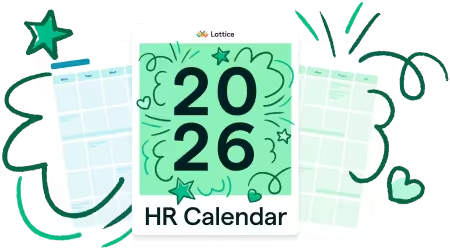Shared Parental Leave Policy Template


Download this template for free
By submitting your information, you agree to Lattice's Terms of Service and Privacy Policy. You can opt out anytime.
Thanks! We'll be in touch soon.
As workplace expectations evolve to support greater equity and flexibility, Shared Parental Leave (SPL) has emerged as a powerful tool for companies looking to offer more inclusive benefits for working families. SPL allows eligible parents to share up to 50 weeks of leave and up to 37 weeks of pay after the birth or adoption of a child — empowering both partners to participate in early caregiving responsibilities.
For organizations, a clear and well-communicated Shared Parental Leave Policy ensures compliance with UK employment law while signaling a commitment to family-friendly practices. Whether employees take their leave simultaneously, in alternating blocks, or at different times altogether, a strong policy makes it easier for people teams and managers to plan coverage and support returning parents effectively.
What a Shared Parental Leave Policy Should Include
A well-written Shared Parental Leave Policy should outline:
- Eligibility criteria: Who qualifies for SPL, including employment length, earnings thresholds, and relationship to the child.
- Amount of leave available: How much leave can be shared and when it can be taken.
- Notice requirements and documentation: How and when employees must notify their employer, and what documentation they need to provide.
- How SPL interacts with other types of leave: Including maternity, adoption, or paternity leave.
- Process for booking and varying leave: Whether SPL must be taken in continuous or discontinuous blocks and how to request changes.
- Pay during SPL: Details of Statutory Shared Parental Pay (ShPP), and whether the employer offers enhanced pay.
- Rights during and after SPL: Protection from discrimination or detriment, and rights to return to work.
- Manager and HR responsibilities: Guidance for supporting employees before, during, and after their leave.
Purpose of a Shared Parental Leave Policy
The Shared Parental Leave Policy gives employees and managers a clear framework for navigating shared leave entitlements. It helps ensure that all requests are handled fairly, lawfully, and consistently — while also giving the organization time to plan and maintain operational continuity.
More broadly, a SPL policy reflects your company’s values and commitment to gender equity, inclusive parenting, and employee wellbeing. It creates space for both parents — not just birthing parents — to bond with their children, normalize caregiving responsibilities, and reduce the career penalties often associated with parental leave.
Shared Parental Leave Policy Template
{{rich-highlight-1}}
1. Purpose
This policy outlines the rights and responsibilities of employees who wish to take Shared Parental Leave (SPL) and/or Statutory Shared Parental Pay (ShPP) following the birth or adoption of a child. It ensures compliance with relevant UK legislation and supports a family-friendly workplace culture that empowers both parents to participate in early childcare.
2. Scope
This policy applies to all employees of [Company Name] who meet the statutory eligibility criteria for SPL and/or ShPP. It applies in cases of childbirth and adoption where the expected week of birth or placement is on or after 5 April 2015.
3. Definitions
- SPL (Shared Parental Leave): Up to 50 weeks of leave that eligible parents can share in the first year following the birth or adoption of a child.
- ShPP (Statutory Shared Parental Pay): Up to 37 weeks of pay available to eligible employees while on SPL.
- Mother/Primary Adopter: The person who has given birth or is the main adopter of the child.
- Partner: A spouse, civil partner, or partner living in an enduring family relationship with the mother/primary adopter and the child.
4. Eligibility Criteria
To qualify for SPL and/or ShPP, the employee and their partner must meet specific eligibility requirements.
For SPL:
- The mother/adopter must be entitled to statutory maternity/adoption leave (SML/SAL) or pay (SMP/SAP), and must curtail their entitlement early.
- The partner must be an employee who has worked for [Company Name] continuously for at least 26 weeks by the end of the 15th week before the expected week of childbirth (EWC) or placement date.
- Both parents must meet the "employment and earnings test" — the partner must have worked at least 26 of the 66 weeks before the EWC/placement and earned at least £30 a week in 13 of those weeks.
For ShPP:
- The employee must have average weekly earnings at or above the lower earnings limit set by the government for National Insurance purposes.
5. Entitlement
Eligible parents can share:
- Up to 50 weeks of leave (minus any maternity or adoption leave taken)
- Up to 37 weeks of pay (minus any statutory maternity/adoption pay taken)
SPL must be taken within 52 weeks of the child’s birth or placement. Leave can be taken simultaneously, in alternating blocks, or at separate times, subject to notice and approval.
{{rich-highlight-3}}
6. Curtailment of Maternity/Adoption Leave
The mother/adopter must give notice to end their maternity/adoption leave early — known as a “curtailment notice” — and must:
- Do so at least 8 weeks before the leave is to end
- Still be on maternity/adoption leave at the time of giving notice
This allows the partner to access shared leave.
7. Notice Requirements
To take SPL, employees must submit:
- Curtailment notice (if applicable): Provided by the mother/adopter to end their SML/SAL early.
- Notice of entitlement and intention: This outlines how much leave each parent plans to take and when.
- Booking notice: At least 8 weeks before each intended block of leave. Employees can make up to three separate requests (including variations).
All notices must be submitted in writing to HR and include:
- The start and end dates of each block of leave
- A signed declaration from both parents confirming eligibility and sharing arrangements
8. Leave Structure
SPL may be taken in:
- Continuous blocks: A single, unbroken period of leave (must be approved).
- Discontinuous blocks: Multiple blocks with breaks in between (subject to agreement).
Managers should consider operational needs and employee wellbeing when reviewing discontinuous leave requests. If agreement cannot be reached within 14 days, the employee may withdraw the request or proceed with a continuous block.
9. Statutory Shared Parental Pay (ShPP)
Eligible employees may receive up to 37 weeks of ShPP, paid at the statutory rate (or 90% of average weekly earnings, if lower). [Company Name] may choose to enhance this as part of its family leave benefits.
Pay may be shared between parents and must align with the leave taken. Employees receiving ShPP must give at least 8 weeks’ notice of each period of payment.
10. Rights During and After Leave
While on SPL, employees remain entitled to:
- Accrual of annual leave
- Access to non-pay contractual benefits
- Protection against unfair dismissal or detriment for taking SPL
Employees have the right to return to the same role after any period of SPL of 26 weeks or less. If leave exceeds 26 weeks, they are entitled to return to the same or a similar role with equivalent terms.
11. Keeping in Touch (KIT) and Shared Parental Leave in Touch (SPLIT) Days
Employees on SPL may work up to 20 optional SPLIT days without ending their leave or pay. These days are agreed between the employee and their manager and are not mandatory.
SPLIT days can be used for training, team meetings, or to ease the return to work.
12. Manager and HR Responsibilities
Managers are responsible for:
- Receiving and reviewing SPL notices
- Discussing leave options and timelines with the employee
- Approving or negotiating leave requests
- Supporting the employee’s reintegration post-leave
HR is responsible for:
- Confirming eligibility and processing notices
- Recording SPL and ShPP
- Providing benefits and policy guidance
- Ensuring legal compliance
Frequently Asked Questions
Can both parents take Shared Parental Leave at the same time?
Yes. Eligible parents can take SPL at the same time or in turns, as long as the total amount of leave taken does not exceed 50 weeks.
Is Shared Parental Leave paid?
Yes, if the employee qualifies for ShPP. Statutory ShPP is available for up to 37 weeks, but not all employees may qualify. Some employers choose to offer enhanced ShPP above the statutory amount.
How many SPL requests can an employee make?
Employees can submit up to three booking notices for SPL. This includes requests to vary a previously agreed block of leave.
Can I take SPL if my partner is self-employed?
Possibly. If the self-employed partner meets the employment and earnings test, and the mother/adopter curtails their leave/pay, then the employed partner may be eligible for SPL.
What happens if a request for discontinuous leave is denied?
If a discontinuous leave request cannot be agreed upon within 14 days, the employee may:
- Withdraw the request within 15 days of the original submission
- Take the total amount of requested leave as a continuous block, starting on the original start date
- Submit a new booking notice later
{{rich-highlight-2}}
🚩 Please note: This sample policy is for informational purposes only and does not constitute legal advice. It is a generic template that may not suit your specific circumstances. When adopting or revising a policy, consult legal counsel to ensure compliance with all applicable laws and regulations.
✨ Disclaimer: This resource was developed with the help of artificial intelligence, though reviewed, edited, and approved by (real) humans.
Frequently Asked Questions

Your people are your business
Ensure both are successful with Lattice.





.webp)